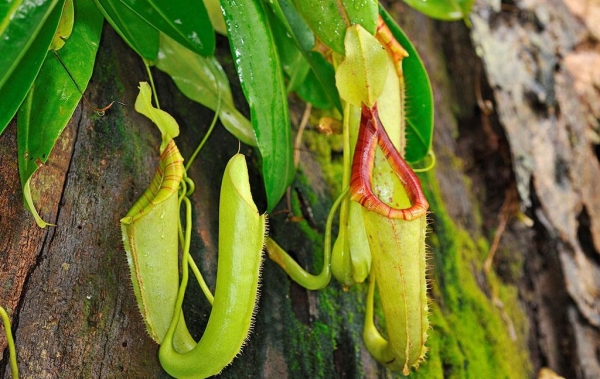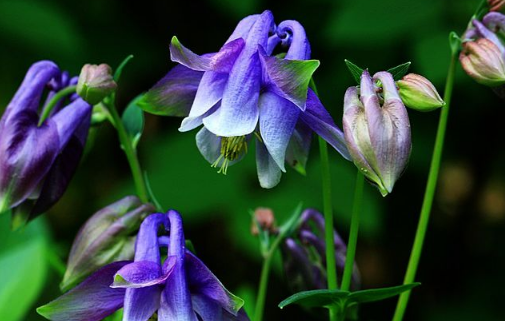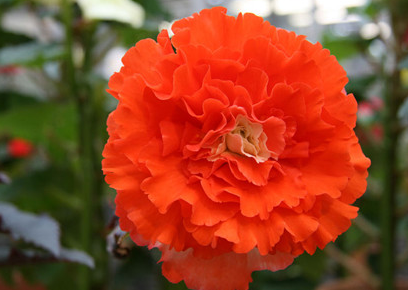Matters needing attention in breeding pitcher plants
Nepenthes is a tropical plant that likes high temperatures, but is not cold-resistant, so it has to winter indoors. And although it is a tropical plant, it can grow in the sun, but afraid of strong light. In summer, pay attention to sun protection. The usual practice is to put up a sunscreen. But don't move Nepenthes plants directly to shade to avoid direct sunlight. If Nepenthes plants get less light, they will grow slowly!

The above is about the effect of Nepenthes introduction, after reading is not the heart also want to plant a pot at home? Although Nepenthes has many effects, it should also be noted that its juice is poisonous. Do not touch or eat it directly when breeding!
Nepenthes cultivation methods Nepenthes cultivation precautions
Nepenthes is a general term for all species of Nepenthes. Nepenthes plants have racemes with green or purple flowers, and the bottle-like body at the top of the leaf is a tool for catching insects. Now that your home is full of flowers and plants, would Nepenthes be an option for you? So, what do we have to pay attention to when farming? Let's take a look at it together.
Cultivation method of Nepenthes
Nepenthes can be grown in greenhouses. The lowland pitcher plants with lower planting difficulty include Nepenthes indiana, Nepenthes khmer, Nepenthes exotic, etc., while the highland pitcher plants include Nepenthes pote, Nepenthes wingii, Nepenthes viki, etc. Nepenthes plants require a variety of growing environments and conditions. Because hybrids are more adaptable, it is difficult to sum up all the habits of purebreds and hybrids in a few words. Planting can be done to improve the environment in response to Nepenthes needs. Improve the environment unsuitable for Nepenthes growth in planting environment. The basic requirements for Nepenthes growth are: light, moisture, humidity, temperature, nutrients and growth substrate.
Nepenthes 'cage is a deformed leaf, so it ages and dies like the leaves of other plants. In general, each cage can survive for several months under suitable conditions. When it has withered, it can be cut off to make the whole plant look more beautiful, but this is purely for the sake of beauty and has nothing to do with the health of the plant. Nepenthes has no dormancy.
The optimum temperature for the growth of Nepenthes is 25~30℃, 21~30℃ from March to September, and 18~24℃ from September to March of the following year. Winter temperature is not lower than 16℃, plant stops growing below 15℃, leaf edge suffers freezing injury below 10℃.
Nepenthes are sensitive to moisture. Nepenthes can only grow normally under high humidity conditions, and water should be sprayed frequently during the growth period, 4~5 times a day. If the temperature changes too much, too dry, will affect the formation of leaf cages. Nepenthes are epiphytic plants, often growing under large forests or on the north side of rocks, and the natural conditions are semi-shady. Under the direct sunlight in summer, shade must be provided, otherwise the leaves are easy to burn and directly affect the development of leaf cages. However, under long-term dark conditions, the cage formation is slow and small, and the cage surface color is dim. The soil should be loose, fertile and breathable decaying soil or peat soil. A mixture of peat soil, moss, charcoal and fir bark is commonly used in potted plants.
Light.
Light is one of the most important factors in raising large, brightly colored traps. Providing enough air humidity, moderate soil moisture and plenty of light can give the leaves a red wine color. Plants can be acclimated to receive some direct sunlight, preferably morning sunlight. Full sunlight, on the other hand, dulls the plant's color and hinders plant growth. Bright light burns quickly, first only the old cage is burned or dehydrated, and finally the whole plant is damaged. When a plant grows into a new cage, it indicates that the plant has adapted to its new environment. In general, more light causes plants to grow bigger and brighter cages. While providing sufficient light, it is also necessary to maintain a high air humidity at all times, especially in strong winds and dry and hot weather. So bright astigmatism is better for pitcher plants. When using sun-shading net, the shading rate is 50~80%. If it is planted in a plastic shed, it is best to use transparent polyethylene film. In addition, the length of sunlight also affects how much light the plant absorbs. Most pitcher plants can tolerate light deprivation, but this limits their growth rate and requires less watering. When Nepenthes gets enough light, it reflects on the size and color of the cage. If Nepenthes is suffering from insufficient light, it can be beneficial to provide artificial supplementary light for a few hours if conditions permit.
Moisture.
Nepenthes plants do not have high requirements for moisture content in cultivation media, and Nepenthes plants generally prefer excessively moist and airtight cultivation substrates. Unlike other insectivorous plants, which only need to keep the soil moist during the growing season, pitcher plants need to keep the soil moist at all times. The matrix should not squeeze out water and be loose. Therefore, the method of watering is more suitable for pitcher plants. However, water can still be supplied by immersion, but it is necessary to improve the permeability of the cultivation substrate and increase the proportion of large-grain cultivation substrate to avoid excessive wetting of the cultivation substrate.
Although all carnivorous plants require soft water with less minerals to grow, Nepenthes is relatively lax about water quality, but this does not mean that Nepenthes does not need high quality water. Due to the long cultivation period of Nepenthes, a potential problem with the immersion method is salt accumulation. There will be a lot of yellow-white scale on the surface of the cultivation medium, which is formed by the precipitation of salt in the water, which has a bad effect on the growth of Nepenthes. The condition can be improved by removing the top layer of substrate and re-laying a new layer of substrate.
Humidity.
The humidity of the air is the key to whether Nepenthes can normally produce bottles.
Under natural conditions, Nepenthes plants usually grow in relatively humid areas with at least 60% humidity. Therefore, in cultivation, many people always encounter the problem that pitcher plants cannot grow new cages; the bottles often wither before they grow up. Nepenthes do not grow cages, mostly because the environment is too dry. But this does not mean that the water is not enough, but that the humidity of the air is too low. To increase the humidity of the air, you can cover the whole pitcher plant with a transparent plastic bag, so that you can easily get a high humidity environment. Place pitcher plants in an aquarium or in a corner. Humidity will increase if ventilation is reduced. However, Nepenthes also has the ability to adapt to the environment, as soon as new traps grow, try to gradually reduce the humidity of the air, so that Nepenthes suitable for a drier environment.
Temperature.
Nepenthes plants are found at a wide range of altitudes, from flat to high mountains above 3,000 meters. In horticulture, they are divided into two main groups according to their altitude distribution: highland species and lowland species. Nepenthes species growing in the mountains above 1200m altitude are upland species, and their cultivation temperature is 21℃ during the day and 10℃ at night; Nepenthes species growing in the flat or below 1200m altitude are lowland species, and their cultivation temperature is 29℃ during the day and 21℃ at night. The temperature difference between day and night is very helpful for the growth of pitcher plants, but the change of seasons is not important. Lowland pitchers grow at low latitudes, where seasonal variations are not obvious and temperatures do not vary much throughout the year. However, Nepenthes upland grows on high mountains and is characterized by a large temperature difference between day and night, which can reach more than 10 ° C.
Cautions for Nepenthes farming
1. Nepenthes flowers have no ornamental value, the flowers are small and flat, only a few varieties of flowers are more bright, in addition, Nepenthes flowers will also emit a bad smell, so try not to cultivate indoors, courtyard balcony is the best choice.
2. Nepenthes is a vine plant that must be attached to stand, so it is necessary to set up a support for Nepenthes. In order to erect the support, it is necessary to use a larger flowerpot. On the other hand, a larger flowerpot can hold more cultivation value, so that the flowerpot is stable and heavy, and can support large pitcher plants without being blown down by the wind.
After reading the above introduction on Nepenthes cultivation methods and precautions, do you have more understanding of Nepenthes cultivation methods? If you want to know more about Nepenthes, please continue to pay attention.
Pitcher farming conditions Pitcher farming precautions
What plant is Nepenthes? This is very common, you will know when you see it, here to understand the cultivation conditions of Nepenthes, Nepenthes cultivation precautions.
Pitcher farming methods and precautions:
1. Temperature: Cage grass likes high temperature environment and grows vigorously at 20--30 degrees Celsius. In cold winters, Nepenthes almost stops growing. To prevent Nepenthes from freezing to death, you need to warm them up. Ensure that the indoor temperature is not lower than 10 degrees Celsius.
Humidity: The air humidity is the key to whether Nepenthes can normally produce bottles. To increase the humidity of the air, you can use a transparent plastic bag to cover the whole pitcher plant, you can easily get a high humidity environment. In addition, the pitcher plant placed in the aquarium, or placed in the corner to reduce ventilation, humidity will increase.
Light: Nepenthes plants like sunlight, but they are afraid of direct sunlight. So in summer to pay attention to sun protection, the general method is to take shade net. Less sunlight is also bad, resulting in slower growth of Nepenthes plants, thin plants, smaller cages or no cages at all.
4, water: Nepenthes need a large amount of water, when the temperature exceeds 30 degrees, watering 2-3 times a day. If conditions permit, it is best to spray water vapor on the branches and leaves of Nepenthes. You can add less water when the temperature is cooler, but still keep the soil moist all the time.
5. Fertilization: Organic fertilizer is generally applied to Nepenthes, and watering is timely after fertilization. If organic fertilizer is not available, or if you hate organic fertilizer, apply a little fertilizer, and keep the amount of fertilizer low. Too much fertilizer at a time can cause plants to wither, as if they were running out of water. In addition to these fertilizers, leaf fertilizer can also be applied, and the fertilizer effect is faster.
6. Substrate: Nepenthes likes a substrate that is sufficiently loose and well drained, and can fully retain water and provide sufficient water for plants. Based on coconut shells, mixed substrates of sawdust and pearlite or pure water moss are ideal for Nepenthes. The water moss is not only suitable for the growth of Nepenthes, but also a sign of whether the planting environment is suitable for Nepenthes growth.
7, breeding precautions:
(1)The flowers of Nepenthes have no ornamental value, the flowers are small and flat, only a few varieties of flowers are more bright, in addition, Nepenthes flowers will emit a bad smell, so as far as possible do not grow indoors, courtyard balcony is the best choice.
(2)Nepenthes are vine plants that must be attached in order to stand, so they need to be set up on supports. In order to erect the support, it is necessary to use a larger flowerpot. On the other hand, a larger flowerpot can hold more cultivation value, so that the flowerpot is stable and heavy, and can support large pitcher plants without being blown down by the wind.
The above is the relevant introduction of this article, I believe you have read it after a simple understanding of this, if necessary, you can continue to pay attention to No.1 home network, to learn more information.
- Prev

Matters needing attention in the culture of Rabdosia angustifolia
Diseases and insect pests the main pest is aphids, the harm is relatively great, it will also cause mosaic disease, in addition, there is the harm of powdery mildew, which needs timely and reasonable treatment. The above is an introduction to the content of Douzi. I hope this article can help the flower friends who are breeding it.
- Next

Maintenance methods of Begonia bulbosa
Watering Begonia likes the moist growth environment, but it is afraid of waterlogging, so it is best not to have stagnant water. When the weather is dry in summer, the air humidity should be increased by spraying water, watering should be reduced in autumn and winter in dormant period, and watering should also be reduced in the budding and flowering period of Begonia bulb.
Related
- Fuxing push coffee new agricultural production and marketing class: lack of small-scale processing plants
- Jujube rice field leisure farm deep ploughing Yilan for five years to create a space for organic food and play
- Nongyu Farm-A trial of organic papaya for brave women with advanced technology
- Four points for attention in the prevention and control of diseases and insect pests of edible fungi
- How to add nutrient solution to Edible Fungi
- Is there any good way to control edible fungus mites?
- Open Inoculation Technology of Edible Fungi
- Is there any clever way to use fertilizer for edible fungus in winter?
- What agents are used to kill the pathogens of edible fungi in the mushroom shed?
- Rapid drying of Edible Fungi

